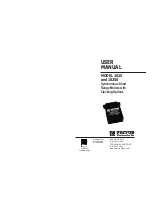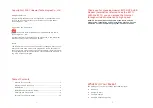
APPENDIX A
SPECIFICATIONS
Transmission Format: Synchronous, full duplex
Transmission Line: Two unconditioned twisted pair 19 - 26 AWG
Clocking: Internal, external or receive loopback
Range: (See table below)
Interfaces: EIA RS-232, CCITT V.24
Data Rates: 1.2 - 19.2 Kbps
Isolation: Minimum 1500 V RMS via custom transformers
Surge Protection: 600W Surge Protection (10x1000µs waveform)
(Model 1025S)
Control Signals: CTS turns on 8 or 53 mS (switch selectable) after
the terminal raises RTS; DSR and DCD are constantly on
Connectors: DB-25 male or female on RS-232 side; RJ-11, RJ-45 or
terminal block with strain relief on line side
Power Supply: No external power required; uses power from EIA
data and control signals
Temperature Range: 0-60°C (32-140°F)
Altitude: 0-15,000 feet
Humidity: Up to 95% non-condensing
Dimensions: 2.66” x 2.10” x 0.73”
Weight: 2 oz.
4.2.2 CONNECTION TO A “DCE” DEVICE
Since the Model 1025 is wired as a DCE, you cannot connect it
directly to another DCE such as a modem, multiplexer or printer. If you
need to connect the Model 1025 to another DCE device, you must use
a
null modem cable wired according to diagram below. We recom-
mend that the cable is as short as possible, preferably 6 feet or less.
Connection to Model 1025
†
Connection to DCE Device
DB-25 Pin No.
DB-25 Pin No.
1......................................................1
2......................................................3
3......................................................2
4......................................................8
8......................................................4
6....................................................20
20......................................................6
17....................................................24
24....................................................17
7......................................................7
†
Note: When connecting to another DCE device, the Model 1025
should be configured for “external clock” (see Section 3.2).
4.3 OPERATING THE MODEL 1025
Once the Model 1025 is properly configured and installed, it should
operate transparently—as if it were a standard cable connection.
Operating power is derived from the RS-232 data and control signals;
there is no “ON/OFF” switch. All data signals from the RS-232 inter-
face are passed straight through. All control signals from the RS-232
interface are looped back.
Note: If your system requires
hardware flow control, you will need
the Patton Model 1030 or Model 1070 Short Range Modem. Call
Patton Customer Service at (301) 975-1007 for more information.
13
14
Data
Rate
19,200
7.5
3.5
2.5
9,600
10.0
3.5
2.5
4,800
10.0
7.0
4.0
2,400
10.0
8.5
5.0
1,200
11.0
8.5
6.0
Model 1025 Distance Table (miles)
Wire Gauge
19
24
26



























